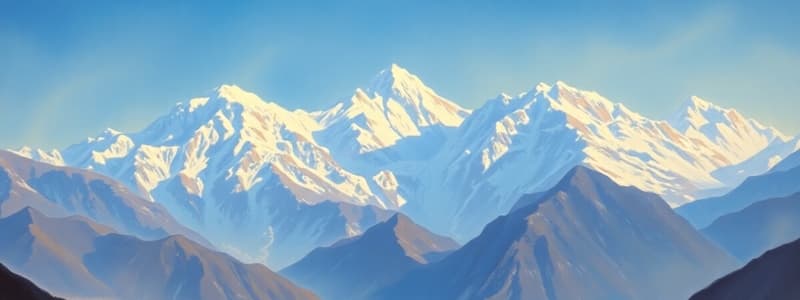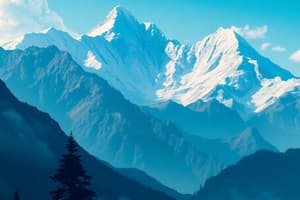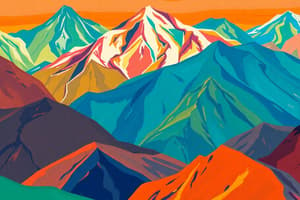Podcast
Questions and Answers
Which of the following processes is primarily responsible for the formation of the Himalayan mountain range?
Which of the following processes is primarily responsible for the formation of the Himalayan mountain range?
- Erosion by major river systems over millions of years
- Volcanic activity along tectonic plate boundaries
- The collision of the Indian and Eurasian tectonic plates (correct)
- The gradual accumulation of sediment from the Bay of Bengal
What is the primary reason the Himalayan region is prone to earthquakes and landslides?
What is the primary reason the Himalayan region is prone to earthquakes and landslides?
- Heavy monsoon rains causing soil saturation
- The presence of numerous glacial lakes
- Ongoing tectonic activity due to plate collision (correct)
- Deforestation leading to unstable slopes
How do the Himalayas influence the climate of the Indian subcontinent?
How do the Himalayas influence the climate of the Indian subcontinent?
- By creating a desert climate in the northern plains of India
- By increasing the temperature throughout the year
- By diverting all major rivers eastward
- By blocking cold air from the north and causing monsoon rains (correct)
Which of the following rivers does NOT originate in the Himalayan mountain range?
Which of the following rivers does NOT originate in the Himalayan mountain range?
Which range of the Himalayas has the highest average elevation, with many peaks exceeding 6,000 meters?
Which range of the Himalayas has the highest average elevation, with many peaks exceeding 6,000 meters?
What characterizes the composition of the Shiwalik range of the Himalayas?
What characterizes the composition of the Shiwalik range of the Himalayas?
How does the climate vary with altitude in the Himalayan region?
How does the climate vary with altitude in the Himalayan region?
Which of the following is a common tree species found in the Himalayan region?
Which of the following is a common tree species found in the Himalayan region?
What significant environmental challenge is causing glaciers to melt in the Himalayas, posing risks to water resources?
What significant environmental challenge is causing glaciers to melt in the Himalayas, posing risks to water resources?
Why is it important to implement sustainable tourism practices in the Himalayas?
Why is it important to implement sustainable tourism practices in the Himalayas?
What role do the Himalayas play in impacting weather patterns in South Asia?
What role do the Himalayas play in impacting weather patterns in South Asia?
In the context of how the Himalayas impact culture, consider the relationship between the mountains and local traditions, languages and religions. Which statement is most accurate?
In the context of how the Himalayas impact culture, consider the relationship between the mountains and local traditions, languages and religions. Which statement is most accurate?
The Himalayas are a source of various natural resources. What makes sustainable resource management so important in this region?
The Himalayas are a source of various natural resources. What makes sustainable resource management so important in this region?
Which environmental issue is primarily responsible for the increased risk of Glacial Lake Outburst Floods (GLOFs) in the Himalayan region?
Which environmental issue is primarily responsible for the increased risk of Glacial Lake Outburst Floods (GLOFs) in the Himalayan region?
What is a key characteristic of the Lesser Himalayas (Himachal) that distinguishes it from the Greater Himalayas?
What is a key characteristic of the Lesser Himalayas (Himachal) that distinguishes it from the Greater Himalayas?
Flashcards
Himalayas
Himalayas
Mountain range in Asia separating the Indian subcontinent from the Tibetan Plateau.
Himalayan Formation
Himalayan Formation
Collision of Indian and Eurasian tectonic plates.
Himalayan Climate Influence
Himalayan Climate Influence
Blocks cold air, causes monsoon rains.
Major Himalayan Rivers
Major Himalayan Rivers
Signup and view all the flashcards
Greater Himalayas (Himadri)
Greater Himalayas (Himadri)
Signup and view all the flashcards
Lesser Himalayas (Himachal)
Lesser Himalayas (Himachal)
Signup and view all the flashcards
Outer Himalayas (Shiwaliks)
Outer Himalayas (Shiwaliks)
Signup and view all the flashcards
Himalayan Climate Zones
Himalayan Climate Zones
Signup and view all the flashcards
Himalayan Biodiversity
Himalayan Biodiversity
Signup and view all the flashcards
Himalayan Economic Activities
Himalayan Economic Activities
Signup and view all the flashcards
Himalayan Environmental Challenges
Himalayan Environmental Challenges
Signup and view all the flashcards
Himalayan Seismic Activity
Himalayan Seismic Activity
Signup and view all the flashcards
Himalayan Glaciers
Himalayan Glaciers
Signup and view all the flashcards
Biodiversity Hotspot
Biodiversity Hotspot
Signup and view all the flashcards
Himalayan Development Challenges
Himalayan Development Challenges
Signup and view all the flashcards
Study Notes
- The Himalayas are a mountain range in Asia, separating the plains of the Indian subcontinent from the Tibetan Plateau
- Home to some of the planet's highest peaks, including Mount Everest
- "Himalaya" means "abode of snow" in Sanskrit
- The Himalayas stretch across: India, Nepal, Bhutan, Pakistan, and China
- The Himalayan range was formed due to the collision of the Indian and Eurasian tectonic plates
- The collision is ongoing, making the region prone to earthquakes and landslides
- The Himalayas influence the climate of the Indian subcontinent and the Tibetan Plateau, blocking cold arctic air and causing the monsoon rains
- Major rivers such as the Indus, Ganges, and Brahmaputra originate in the Himalayas, providing water to millions of people
- Divided into three parallel ranges: the Greater Himalayas, the Lesser Himalayas, and the Outer Himalayas (Shiwaliks)
Greater Himalayas (Himadri)
- Highest range, with an average elevation of over 6,000 meters
- Includes Mount Everest, K2, Kangchenjunga, and other prominent peaks
- Primarily composed of granite and metamorphic rocks
- Glaciers and snowfields are abundant in this zone
- Sparsely populated due to the harsh climate and rugged terrain
Lesser Himalayas (Himachal)
- Lie south of the Greater Himalayas, with elevations ranging from 3,500 to 4,500 meters
- Composed of compressed and altered rocks
- Includes popular hill stations like Shimla, Nainital, and Darjeeling due to its moderate climate
- Forests, valleys, and agricultural lands characterize the landscape
- More densely populated than the Greater Himalayas
Outer Himalayas (Shiwaliks)
- Outermost range, with elevations typically below 1,500 meters
- Composed of unconsolidated sediments brought down by rivers from the higher ranges
- Prone to erosion and landslides
- Dense forests and valleys are typical in this zone
- Agriculture is practiced in the valleys
Climate
- Varies with altitude
- Lower elevations have a subtropical climate, with warm, humid summers and cool, dry winters
- Higher elevations experience a tundra climate, with cold temperatures year-round
- The highest peaks are permanently covered in snow and ice
- Plays a crucial role in the Indian monsoon system
Flora and Fauna
- Rich in biodiversity, with diverse flora and fauna
- Vegetation ranges from tropical rainforests at lower elevations to alpine meadows and coniferous forests at higher elevations
- Common tree species include pine, deodar, fir, and oak
- Fauna includes snow leopards, Himalayan tahr, red pandas, musk deer, and various species of birds
- Many protected areas and national parks are located in the Himalayas to conserve the region's biodiversity
Socio-Economic Significance
- Provides resources and livelihoods to millions of people
- Agriculture, forestry, and tourism are important economic activities
- Hydropower generation is also significant due to the abundant rivers and steep slopes
- Holds cultural and religious significance for various communities
- Pilgrimage sites like Badrinath, Kedarnath, and Amarnath attract millions of devotees every year
Environmental Challenges
- Faces several environmental challenges
- Deforestation, soil erosion, and landslides are major concerns
- Climate change is causing glaciers to melt, posing risks to water resources and increasing the likelihood of glacial lake outburst floods (GLOFs)
- Pollution from tourism and urbanization is also impacting the region's environment
- Conservation efforts are needed to protect the Himalayan ecosystem and ensure sustainable development
Tectonic Activity
- One of the most seismically active regions in the world
- Earthquakes are frequent due to the ongoing collision of the Indian and Eurasian plates
- Large earthquakes can cause widespread damage and loss of life
- Seismic monitoring and disaster preparedness are crucial in this region
Glaciers
- Home to thousands of glaciers, which are a vital source of water for rivers
- Glaciers are receding due to climate change, affecting water availability and river flows
- The formation of glacial lakes poses a risk of GLOFs, which can cause devastating floods downstream
- Studying glacier dynamics and implementing measures to mitigate GLOF risks are essential
Rivers
- Major rivers originating in the Himalayas include the Indus, Ganges, and Brahmaputra
- These rivers provide water for irrigation, drinking, and industrial purposes
- The Himalayan rivers are also important for hydropower generation and navigation
- Water management and transboundary cooperation are crucial for sustainable use of these rivers
Biodiversity Hotspot
- Recognized as a biodiversity hotspot due to their rich and unique flora and fauna
- Many species are endemic to the region, meaning they are found nowhere else in the world
- Conservation efforts are focused on protecting endangered species and their habitats
- Sustainable tourism and community-based conservation initiatives can help preserve biodiversity
Tourism
- Popular tourist destination, attracting visitors for trekking, mountaineering, and cultural experiences
- Tourism can provide economic benefits to local communities but can also have negative environmental impacts
- Sustainable tourism practices, such as minimizing waste and supporting local businesses, are essential to mitigate these impacts
Mountain Passes
- Have several important mountain passes that connect different regions
- These passes have historically been used for trade and travel
- Some passes are now used for roads and highways, facilitating transportation and communication
Impact on Weather Patterns
- Play a significant role in shaping weather patterns in South Asia
- Act as a barrier to cold winds from Central Asia, keeping the Indian subcontinent warmer
- Influence the monsoon, causing heavy rainfall in some areas and rain shadows in others
Geological Formation
- Formation is a complex geological process
- The collision of the Indian and Eurasian plates caused the uplift and folding of rocks, forming the mountain range
- Process is ongoing, resulting in continued uplift and seismic activity
Impact on Culture
- Have a profound influence on the cultures of the people who live in the region
- Traditional lifestyles, languages, and religions are closely tied to the mountains
- Considered sacred in Hinduism and Buddhism, and many pilgrimage sites are located there
Resources
- Source of various natural resources, including minerals, timber, and medicinal plants
- Sustainable resource management is important to ensure that these resources are used in a way that benefits local communities and protects the environment
Development Challenges
- The Himalayan region faces several development challenges, including poverty, limited access to education and healthcare, and inadequate infrastructure
- Sustainable development initiatives are needed to improve the lives of people in the region while preserving its unique environment and culture
Studying That Suits You
Use AI to generate personalized quizzes and flashcards to suit your learning preferences.
Description
Explore the Himalayas, a mountain range in Asia. Learn about their formation from tectonic plate collisions, geographical span across multiple countries, and influence on climate and major rivers. Discover the range's division into the Greater, Lesser, and Outer Himalayas.




